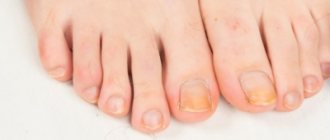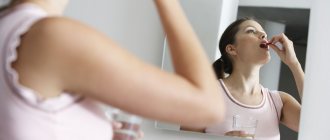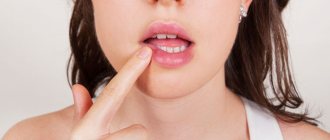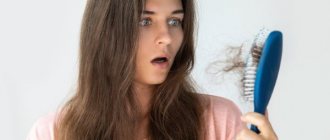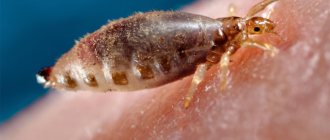Seborrhea of the scalp is a skin disease that occurs as a result of impaired functionality of the sebaceous glands of the skin. Such disorders provoke either excessive production of sebaceous and sweat glands, or cause its deficiency. When seborrhea affects the skin of the scalp, the disease affects not only the gland itself, but also its chemical composition changes. Seborrhea is often confused with dandruff, but this is not entirely correct - in fact, seborrhea is one of the causes of dandruff.
Varieties
Seborrhea of the scalp comes in the following varieties:
- Dry seborrhea. It occurs as a result of decreased secretion of the sebaceous glands of the scalp. With dry seborrhea, the hair becomes dull, falls out, and gray-white flakes of dandruff form on the skin, which are easily separated and combed out with a regular comb.
- Fat. Appears as a result of increased secretion of the sebaceous glands. With this type of disease, the hair is always oily, there are rashes on the skin, and inflammation and ulcers are often a concern. A person is bothered by itching and if such seborrhea of the scalp is not treated, over time the hair thins and bald patches appear.
- Mixed. It manifests itself in the fact that there are signs of oily dermatosis on the head, and dry dermatosis on the face. This type is the most difficult to treat, since different types of seborrhea on the same skin require different approaches to treatment.
Etiology of the disease
The appearance of seborrheic dermatitis is influenced by the presence of two factors - a large secretion of sebum and the presence of the fungus Malassezia furfur. Scientific research has established that the fungus is part of the microflora located on the skin.
Most microorganisms were identified at the location of the hair follicles. This occurs due to the fact that microorganisms feed on subcutaneous fat. When there is enough of it, the fungus develops and grows.
In practice, there are cases when this dermatitis is observed not only in places where hair grows, it can also spread to the face.
Causal factors
If a person does not have excess sebum production, the fungus will not develop. But if he gets into favorable conditions, symptoms of seborrheic dermatitis may begin to appear.
Seborrheic dermatitis can have internal and external causes of its manifestation.
Internal factors include:
- Diseases associated with the digestive system. It could be colitis, hepatitis. With such diseases, metabolism is disrupted, so metabolic products are released through the skin. This process leads to changes in the skin microflora and creates favorable conditions for the development of fungus.
- Low level of immunity. This may be caused by a serious illness or its chronic course.
- Violation of the patient's psycho-emotional background.
- Parkinson's disease or paralysis can cause dermatitis due to this. that the patient begins to move little and sebum accumulates. Such phenomena can cause the development of harmful microorganisms in the form of fungi.
External influences include:
- Harmful microorganisms that can get on the skin. These are staphylococci and streptococci. They help reduce immunity.
- Frequent exposure to alkali on the skin. If you constantly use alkali-based detergents.
- Sudden change in ambient temperature. In the cold season, you must wear a hat, as well as when visiting a bathhouse or in very hot summers.
Most often, seborrheic dermatitis occurs in adolescents, menopausal women, and infants under one year of age. Hereditary predisposition is of no small importance in the manifestation of seborrheic dermatitis.
Types and signs of the disease
Seborrheic dermatitis on the skin has three main forms, depending on which the symptoms of the disease appear. The patient's further treatment depends on them.
Oily seborrhea is the most common, and its manifestations include:
- The glands will secrete a secretion that will be quite oily. At the same time, sebum is an ideal place for the development of bacteria. In this case, harmful microorganisms will appear. Because of this, pustules form, which can damage the walls of the glands. Even in this situation, the sebaceous glands enlarge and they become inelastic. The result is blockage and accumulation of sebum. When mechanically applied to the skin, a yellow substance is released. Whiteheads called comedones may appear in these places. The patient will experience itching and dandruff will begin to appear in the hair. If the scales are oily, they may stick together and transform into plates that have a yellowish-gray tint. These manifestations are observed in the scalp, but they can also be cured.
- If comedones appear on the face, the hair takes on an oily appearance. They may clump together and will always appear dirty.
Dry seborrhea is rarely diagnosed:
- It occurs due to insufficient sebum secretion.
- It usually appears in children at an early age, before hormonal changes occur.
- During this period, there may be poor development of the sebaceous glands, which are located in the scalp. Treatment must be used in combination.
- These manifestations are also observed in older people. At the same time, the hair becomes fragile, brittle, and may fall out. Dandruff will appear on the entire surface of the head in the hair area. The scales that form may be white or yellow.
- Severe flaking and itching will be observed on the scalp. The scalp will be dry and itchy. All these manifestations worsen after washing your hair. They become especially noticeable if cold water was used.
- Reddish spots will begin to appear on the skin, they are called seboreids. Therefore, harmful microorganisms develop in the scalp, and this can lead to thickening of the skin and itching. How severe these symptoms will be depends on the individual characteristics of the patient. The scalp may be dry and flaky, but when visiting the clinic, a dermatologist will be able to diagnose dry seborrheic dermatitis.
In medical practice, mixed seborrheic dermatitis occurs on the skin. In this case, symptoms of oily and dry forms of the disease may occur. This variant is observed in the scalp or facial skin.
The causes of any type of dermatitis on the scalp also depend on the influence of external factors. Establishing them will help cure the disease.
Causes of seborrhea
There are many reasons for the appearance of seborrhea, all associated with hormonal imbalance. Teenagers often suffer from seborrhea during puberty. In some adults, the disease is chronic.
Possible causes of seborrhea:
- stress;
- chronic fatigue;
- an excess of sweet, salty, spicy foods in the diet;
- unbalanced diet;
- indigestion;
- failure to comply with personal hygiene rules;
- testicular tumor (in men);
- ovarian disease (in women);
- hereditary factor;
- disruption of the endocrine glands;
- diabetes;
- destructive influence of the environment;
- weakening of the immune system.
If the barrier and secretory functions of the skin are disrupted, the body cannot cope with the growth of pathogenic fungal microflora that lives in the stratum corneum of the skin where the secretory work of the sebaceous glands is excessive, microbes actively multiply and cause peeling of the skin.
Severe seborrhea can cause the appearance of red plaques on the skin or even crusts with bloody discharge. In parallel with this, the disease can manifest itself in other areas of the face and body - on:
- eyebrows,
- wings of the nose,
- next to the ears,
- neck,
- décolleté area.
Seborrhea of the scalp is not contagious, does not pose a danger to others, and is not transmitted from sick people to healthy people using all known routes of transmission of infections.
The disease cannot be neglected, because hair will begin to fall out rapidly. Contact a dermatologist if there are precedents.
How to Avoid Seborrheic Dermatitis
As a form of prevention, you can suggest maintaining personal hygiene: you need to wash your face early in the morning, when you just wake up and after work, using special lotions suitable for your skin type. It is advisable to select shampoos for the appropriate hair type (oily, dry, dyed). To avoid counterfeits, it is better to buy shampoos in pharmacies.
For people with oily skin, it is recommended to treat the skin with medicinal preparations in alcohol or aqueous solutions. Ultraviolet radiation from the sun has a good effect on the skin, but you should not sunbathe until you get burned.
Take vitamin A regularly, it is most abundant in carrots. For better absorption by the body, it is best to make a carrot salad dressed with oil. Regularly undergo medical examinations to identify diseases, preventing the disease from becoming chronic.
The main signs of seborrhea of the scalp are oily skin, flaking and itching of the skin, hair loss, and severe dandruff.
The main feature of seborrhea from dandruff is that dandruff can appear not only as a result of the disease, but also from a number of other reasons: inappropriate shampoo, poor care. Such dandruff does not lead to changes in the structure of the sebaceous gland.
Seborrhea of the scalp is divided into 3 types: oily, dry and mixed.
Drug treatment of seborrhea
The patient needs to be examined by doctors: a gastroenterologist and an endocrinologist. Only a doctor will prescribe pharmaceuticals.
Treatment with medications usually lasts 1 - 2 months, depending on the degree of damage to the scalp. Then, it is necessary to carry out prevention.
The following types of drugs against seborrhea are used:
- Antifungal agents (Ketonazole, Bifonazole) inhibit fungal activity.
- Multivitamin complexes (Hexavit, Revit) compensate for the lack of vitamins.
- Brewer's yeast in tablets improves the condition of the scalp, nails and hair.
- Biogenic preparations (Kombutek, Pyrogenal) improve metabolism and prevent hair loss.
- Medicinal shampoos and ointments facilitate hygienic care of the scalp.
Treatment methods
Seborrhea is treated only in combination with the underlying disease. For quick and successful treatment, self-care of your skin and hair is important. For these purposes, it is best to buy medicinal shampoos and ointments at the pharmacy. It is also important to be observed by a specialist during the course of treatment for seborrhea.
With seborrheic alopecia, it is necessary to stay bareheaded in the sun for as long as possible in the summer, unless there are other contraindications to this.
Do not hesitate to contact specialist doctors. It’s better to sleep peacefully if you find out that you have dandruff only because you didn’t wash your hair well with shampoo.
Use of external preparations
To treat the scalp for medicinal purposes, as well as as a preventative measure, medications are used - special ointments and medicated shampoos.
Shampoos with an antimycotic effect (the range is large Friederm-tar, Losterin, Nizoral, Keto plus) which contain ketoconazole and erythromycin.
During treatment, the doctor may recommend using medicated shampoo daily, and after remission occurs, use it as a means of prevention no more than 2-3 times a month. Such shampoos have an antiseptic effect, relieve itching, reduce flaking, and improve the general condition of the scalp and hair.
Sulfur ointment and boric acid are used for external treatment of dry seborrhea. Initially, sulfur ointment is rubbed into the scalp for 8 days, after which they take a break for 1 day and only after that the hair is thoroughly washed with medicated shampoo. The next day after washing the hair, further treatment with boric acid begins. The drug is diluted with hot water (2 tsp per 150 ml) and rubbed into the scalp. The procedure is carried out at night, after which the hair is wrapped and gone to bed.
Manipulations with boric acid should be carried out for three days. It is recommended to use medicated shampoo no earlier than 7 days after the end of the last manipulation.
For oily seborrhea, the following drugs are used to rub into the scalp - ointments or alcohol tinctures containing lithium, tar, zinc, sulfur, resorcinol.
Physiotherapeutic treatment of scalp seborrhea
Physiotherapy enhances the effect of drug therapy and helps stimulate hair follicles.
- Cryomassage of the scalp. Under the influence of cold, blood vessels narrow, inflammation is relieved, and the secretion of the sebaceous glands is normalized.
- Magnetotherapy. This procedure is based on the therapeutic effect of a low-frequency alternating magnetic field.
- Electroporation. This is the effect of a simulated electric pulse current through pores in the lipid membrane.
- Darsonvalization. Involves the use of high-frequency pulsed electric current. This procedure increases skin tone, enhances blood and lymph circulation, affects peripheral nerve endings and normalizes the absorption capacity of the skin;
- Laser puncture. This is a relatively new physiotherapeutic method used in the treatment of seborrhea of the scalp. Its essence lies in the transdermal effect of low-energy laser radiation on biologically active acupuncture points.
Diet. When treating seborrhea, you should limit your intake of sweet, fatty, salty and spicy foods, and also give up baked goods and canned foods, giving preference to a dairy-vegetable diet.
Also, do not forget that the key to effective treatment and an important aspect of prevention is increasing general physical activity, hardening the body and regular exposure to fresh air.
How to treat at home?
Folk remedies
Treatment of seborrhea should be comprehensive. Traditional medicine is usually used as an adjunct to drug therapy.
Before using folk remedies, you should consult a doctor. Self-medication is unacceptable.
Treatment of oily seborrhea of the head:
- Mix a tablespoon of onion juice with two tablespoons of water. Rub in the solution before each shampoo. The duration of the course should be 4 months. The effect will appear faster after rinsing your hair with an infusion of onion peels.
- Calendula is able to well regulate the functioning of the sebaceous glands. The product is suitable for the treatment of oily and dry seborrhea. Included in many shampoos for oily hair. Pour a tablespoon of dried flowers into two glasses of boiling water, leave for half an hour, rub into the hair roots every day. The solution will strengthen the hair, which makes calendula an even more effective remedy if the disease is accompanied by hair loss. The infusion can be mixed with a strong decoction of burdock roots. Suitable for prevention and simple scalp care for seborrhea.
- It is useful to acidify the diseased skin with vinegar or lemon juice. Pour a tablespoon of 9% vinegar into a liter of water. After washing, the hair is rinsed with this solution. Pour 100 g of fresh nettle leaves into 500 ml of boiling water, leave for two hours, add a teaspoon of 6% vinegar, bring to a boil. Before going to bed, moisten the head with infusion. Store it in the refrigerator.
- Two egg yolks, the juice of half a lemon, a tablespoon of vegetable oil are mixed and rubbed into the scalp, which is covered with polyethylene and a warm scarf. Wash off after 40 minutes. The procedure is repeated after three days.
- Fat-dissolving soda can also help treat seborrhea. Moisten the product with water, apply the paste to the scalp, cover with polyethylene and a scarf. Wash off after 40 minutes.
- Pour crushed oak bark into boiling water (1:5), boil over low heat for 20 minutes, pour in the same amount of boiling water, add bee honey (10 g per 250 ml of broth). Rub the decoction into the scalp twice a week for two months.
- Every other day before going to bed, lubricate the scalp with propolis extract. The liquid dries quickly and forms a film. In the morning, remove and wipe the skin with a cotton swab dipped in alcohol. Do 30 procedures, and then take a break for two months. To prepare the extract: propolis is cleaned of impurities, filled with alcohol (1:4), heated in a water bath. After half an hour, propolis dissolves. Excess wax will float to the surface. It needs to be drained and the liquid filtered.
Treatment of dry seborrhea of the head.
With this form of the disease, the skin suffers from a lack of fat. Therapy is aimed at replenishing it through the use of oils.
Do not rub the product into the skin too intensely, otherwise the hair will be pulled out and broken. Excess oil will quickly pollute your hair and make it difficult to sweat properly.
- Pour 300 g of boiling water over two tablespoons of crushed dry nettle leaves, leave for two hours, strain. The infusion is rubbed into the scalp every day.
- Two tablespoons of crushed dry burdock roots are poured into 300 g of boiling water, boiled over low heat until the original volume is halved. Strain, add 50 g of melted lard, simmer in a water bath for about two hours. The ointment is rubbed into the scalp twice a week for three months.
- A tablespoon of onion juice is mixed with two tablespoons of vodka and a tablespoon of castor or burdock oil. Rub in an hour before washing your hair.
- Calendula tincture is mixed with castor oil in equal proportions and rubbed into the hair roots every other day.
- Five tablespoons of walnut leaves are poured into 500 ml of water, the broth is boiled, and filtered. Fold the gauze in four, soak it in the broth, wrap clean hair, cover the head with polyethylene, a warm scarf or towel, and leave for 20 minutes. Then the hair is rinsed with warm water.
- Wash your hair with St. John's wort infusion up to three times a week. Treatment should be no more than 15 procedures. Using the same scheme, you can wash your hair with infusion of sage and wormwood.
- Henna powder is mixed with warm water and nourishing cream (1:2:7). The mixture is rubbed into the scalp twice a week in a course of up to 12 times.
Prevention of seborrhea of the head of all types
If specialists help you decide how to cure seborrhea, then preventive measures fall entirely on your shoulders. To prevent new inflammation of seborrhea on the scalp (relapse), a person should pay special attention to skin hygiene. The choice of hair wash products is made according to your skin type. Seborrhea, which your body has suffered, can return at any, most inopportune moment. It would be useful to take vitamin complexes or preparations rich in minerals. The scalp and hair, under which seborrhea may be hidden, are treated with decoctions of soothing herbs. Your health and beautiful hair appearance are only in your hands.
Seborrheic dermatitis of the scalp is a disease that occurs suddenly and progresses rapidly. If your dandruff has increased, don't wait to see a doctor. Only an experienced specialist will accurately determine the cause of an unpleasant disease without dire consequences. Seborrhea of the scalp should not become your punishment or cause constant stress. Get rid of this unsightly disease once and for all. What is skin dermatitis and can it be cured immediately? The main thing you should stock up on is patience and faith in a quick recovery.
Diet for seborrhea: therapeutic nutrition
Before you start using medications, you should improve your diet. It has a key role in the treatment of the disease. Diet goal:
- strengthen the immune system;
- normalize digestion;
- saturate the body with vitamins, minerals, nutrients;
- remove toxins and waste;
- exclude allergenic foods.
The diet should include low-calorie foods and foods rich in proteins (meat, dairy products, fruits, vegetables), vitamins and minerals.
The patient should forget about food:
- fried,
- fat,
- spicy,
- sweet,
- carbonated drinks,
- coffee,
- fast food,
- semi-finished products
- chips,
- alcohol.
White bread should be replaced with dark varieties.
You should also avoid consuming allergens:
- chocolate;
- nuts;
- cocoa;
- caviar;
- mushrooms;
- honey;
- strawberries;
- citrus.
If a patient has chronic seborrhea, he must constantly follow a diet.
Prevention
In order to prevent the occurrence of seborrhea and prevent seasonal relapses, a number of measures should be taken:
- In case of illness, you should strictly follow all doctor’s prescriptions and adhere to his advice and recommendations.
- Constantly monitor your health. Undergo regular preventive examinations with a gastroenterologist, endocrinologist, neurologist, dermatologist, gynecologist or urologist. Follow all recommendations of these doctors.
- Maintain your immunity at the proper level. To this end, you should lead a healthy lifestyle, give up bad habits, maintain a sleep schedule, and avoid overwork.
- Take walks in the fresh air more often, and engage in feasible sports.
- Properly balance your daily diet, avoiding the consumption of foods that lead to the occurrence or exacerbation of seborrhea.
- If you experience chronic fatigue, insomnia or decreased performance, contact a neurologist.
- Follow hygiene rules - wash your hair and body regularly. Select hygiene and hair care products only based on natural ingredients and in accordance with your skin type.
- Do not wash your hair and hair with too hot water.
- Before the change of seasons in the autumn-spring period, start taking multivitamins.
- As far as possible, within the permissible ambient temperature, prevent hair from matting and fogging under the headdress.
Compliance with these easy-to-follow rules will prevent relapses and provide relief from the non-aesthetic manifestations of seborrhea.
The root causes of seborrhea on the head
Treatment of seborrheic dermatitis on the head begins only after determining the main cause of the disease. The connection between malfunctions in the functioning of the glands that secrete sebum and a decrease in hormonal levels has long been proven. It is easier to recover from such an illness, because eliminating the cause leads to the normalization of all processes on the skin.
Otherwise, the main causes of seborrhea of the head include:
- genetic predisposition;
- primary diseases;
- poor nutrition.
People call seborrhea a family disease, because relatives suffering from a similar illness can pass seborrheic skin dermatitis to their offspring. Heredity plays an important role in the occurrence of scalp disease.
The undoubted “neighbor” of seborrhea is considered to be more complex diseases, such as epilepsy or schizophrenia. Taking potent hormonal drugs leads to increased flaking of the scalp.
The cause of the disease has been determined, all concomitant diseases have been identified, the last unresolved question remains: how to cure seborrheic dermatitis quickly and for a long time?
Poor nutrition causes malfunction of the sebaceous glands




